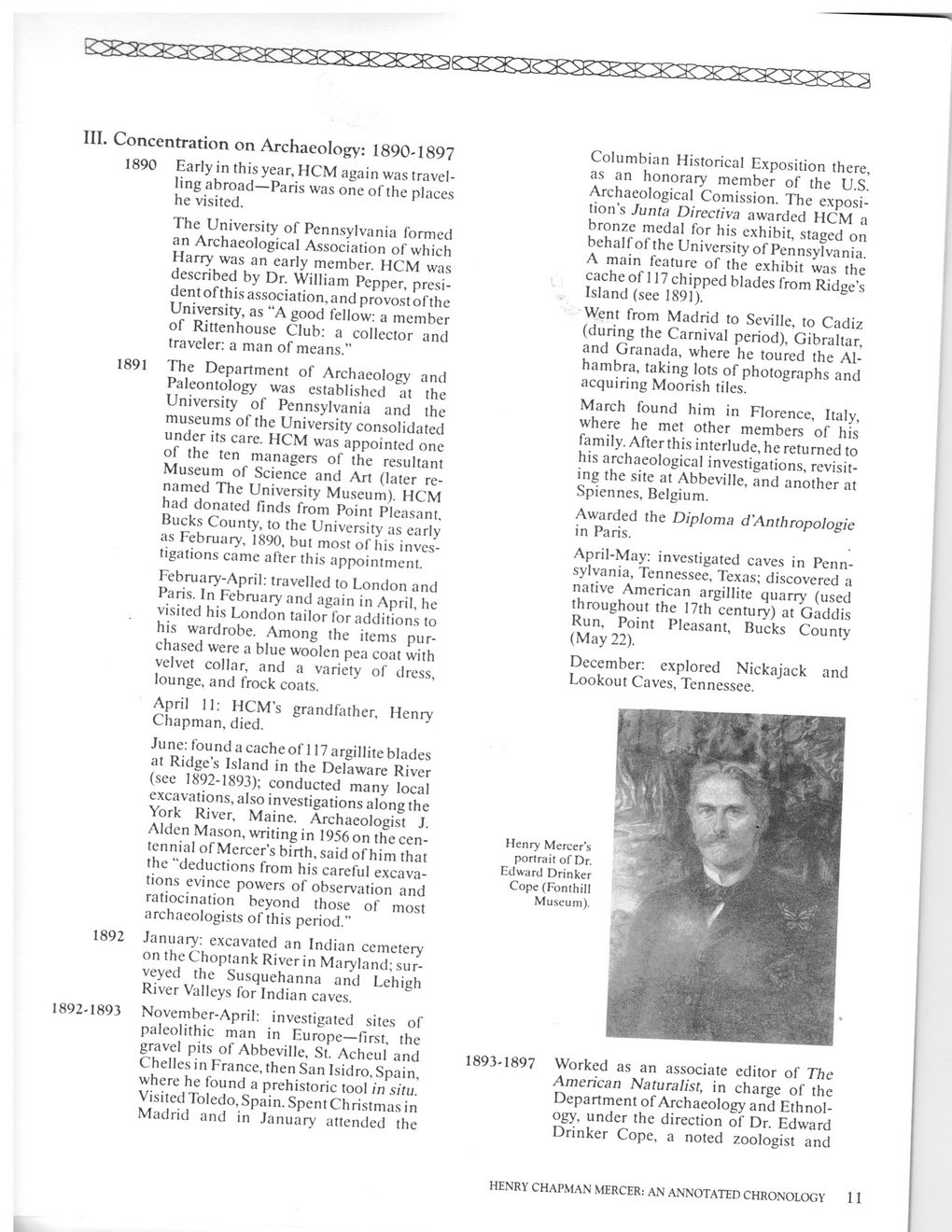This text was obtained via automated optical character recognition.
It has not been edited and may therefore contain several errors.
III. Concentration on Archaeology: 1890-1897 1890 Early in this year, HCM again was travelling abroad—Paris was one of the places he visited. The University of Pennsylvania formed an Archaeological Association of which Harry was an early member. HCM was described by Dr. William Pepper, president ofthis association, and provost of the University, as “A good fellow: a member of Rittenhouse Club: a collector and traveler: a man of means.” 1891 The Department of Archaeology and Paleontology was established at the University of Pennsylvania and the museums of the University consolidated under its care. HCM was appointed one of the ten managers of the resultant Museum of Science and Art (later renamed The University Museum). HCM had donated finds from Point Pleasant, Bucks County, to the University as early as February, 1890, but most of his investigations came after this appointment. February-April: travelled to London and Paris. In February and again in April, he visited his London tailor for additions to his wardrobe. Among the items purchased were a blue woolen pea coat with velvet collar, and a variety of dress, lounge, and frock coats. April 11: HCM’s grandfather, Henry Chapman, died. June: found a cache of 117 argillite blades at Ridge’s Island in the Delaware River (see 1892-1893); conducted many local excavations, also investigations along the York River, Maine. Archaeologist J. Alden Mason, writing in 1956 on the centennial of Mercer’s birth, said of him that the “deductions from his careful excavations evince powers of observation and ratiocination beyond those of most archaeologists of this period.” 1892 January: excavated an Indian cemetery on the Choptank River in Maryland; surveyed the Susquehanna and Lehigh River Valleys for Indian caves. 1892-1893 November-April: investigated sites of paleolithic man in Europe—first, the gravel pits of Abbeville, St. Acheul and Chelles in France, then San Isidro, Spain, where he found a prehistoric tool in situ. Visited Toledo, Spain. Spent Christmas in Madrid and in January attended the Columbian Historical Exposition there, as an honorary member of the U.S. Archaeological Comission. The exposition’s Junta Directiva awarded HCM a bronze medal for his exhibit, staged on behalf of the University of Pennsylvania. A main feature of the exhibit was the cache of 117 chipped blades from Ridge’s Island (see 1891). Went from Madrid to Seville, to Cadiz (during the Carnival period), Gibraltar, and Granada, where he toured the Alhambra, taking lots of photographs and acquiring Moorish tiles. March found him in Florence, Italy, where he met other members of his family. After this interlude, he returned to his archaeological investigations, revisiting the site at Abbeville, and another at Spiennes, Belgium. Awarded the Diploma d'Anthropologie in Paris. April-May: investigated caves in Pennsylvania, Tennessee, Texas; discovered a native American argillite quarry (used throughout the 17th century) at Gaddis Run, Point Pleasant, Bucks County (May 22). December: explored Nickajack and Lookout Caves, Tennessee. Henry Mercer's portrait of Dr. Edward Drinker Cope (Fonthill Museum). 1893-1897 Worked as an associate editor of The American Naturalist, in charge of the Department of Archaeology and Ethnology, under the direction of Dr. Edward Drinker Cope, a noted zoologist and HENRY CHAPMAN MERCER: AN ANNOTATED CHRONOLOGY

Bucks-Mont, Pennsylvania Bucks County Hist Soc - Henry Chapman Mercer (13)